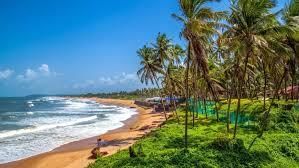GPSC (Goa) Exam > GPSC (Goa) Notes > Goa State PSC (GPSC) Preparation > Goa: Climate
Goa: Climate | Goa State PSC (GPSC) Preparation - GPSC (Goa) PDF Download
Climate of Goa

- Climate Type: Goa has a tropical monsoon climate, characterized by warmth and humidity year-round.
- Temperature Range: Temperatures vary from 20°C to 34°C.
- Diurnal Temperature Range: Temperature variation between day and night is minimal, ranging from 4 to 6°C during the monsoon season, and increases to 10 to 20°C during December and January.
- Temperature Extremes: The highest temperatures occur in the premonsoon months of April and May, while the lowest are in January.
- Humidity: Due to Goa's proximity to the Arabian Sea, humidity remains high throughout the year, varying from 60% to 90%.
- Rainfall: Goa receives substantial rainfall from the Southwest monsoon between June and September, with an average annual rainfall of about 3200 mm.
- Rainfall Distribution: Rainfall increases from the coast to the Western Ghats, from about 2500 mm to over 4500 mm. Over 90% of the rainfall occurs during the monsoon months, with Valpoi and Sanguem receiving the highest amounts.
- Seasonal Variation: July experiences the highest rainfall, which then gradually decreases in subsequent monsoon months. The low-lying coastal areas receive the least rainfall, while the inland hilly areas receive the most.
- Groundwater Recharge: Rainfall is crucial for groundwater recharge in Goa.
- Regional Trends: While the contribution of July rainfall is decreasing in central and west peninsular India, it has increased in the northeastern parts of the country.
- General Temperature: Goa’s tropical weather results in temperatures staying relatively constant between 24°C to 29°C throughout the year. However, in May, temperatures can exceed 33°C.
- Monsoon Effect: The monsoon season from June to September brings lush greenery to Goa.
Weather Pattern in Goa

Temperature and Rainfall in Climate of Goa
- Monsoon: From July to the end of September, with approximately 26 inches of rainfall.
- Winter: From late November to mid-February, with temperatures ranging from a minimum of 3°C to a maximum of 11°C.
- Summer: From mid-March to the end of June, with temperatures ranging from a minimum of 25°C to a maximum of 45°C.
Agro-climatic zone of Climate of Goa
- An “Agro-climatic zone” is defined as a land unit characterized by its major climate types, which determines its suitability for various crops and cultivars.
- The goal of planning within these zones is to manage regional resources scientifically to produce food, fiber, fodder, and fuel wood while maintaining the sustainability of natural resources and the environment. This approach aims to optimize crop yield while preserving ecological balance (FAO, 1983).
Classification by Planning Commission
- The Planning Commission of India (1989) classified the country into various agro-climatic regions based on uniformity in rainfall, temperature, topography, cropping systems, and water resources.
- India is divided into 15 agro-climatic regions.
West Coast Plains and Ghats zone
- Goa falls under the West Coast Plains and Ghats Zone, which includes the west coast of Tamil Nadu, Kerala, Karnataka, Maharashtra, and Goa.
- This zone is characterized by diverse crop patterns, varying rainfall, and different soil types.
IMD (Indian Metrological Department) Goa Center
- Location: The Meteorological Centre Goa is situated in North Goa District at latitude 15° 29' N and longitude 73° 49' E.
- State Overview: Goa, a small and picturesque state renowned for tourism, is divided into two districts—North Goa and South Goa—each further divided into 11 talukas. The total area of Goa is 3702 square kilometers.
- Geography: Located along the Konkan Coast of India, Goa has a coastline of 131 km and features a partly hilly terrain with the Western Ghats rising nearly 1200 meters. The main rivers are the Mandovi and Zuari.
- Climate: Goa receives most of its rainfall from June to September, with an average annual precipitation of 250 cm.
- Historical Context: Goa was a Portuguese colony until December 19, 1961, when Indian military forces, supported by freedom fighters, liberated it. Goa was integrated into the Indian Union and achieved full statehood on May 30, 1987.
- Meteorological Service History: The meteorological service in Goa began as “SERVICO METEOROLOGICO DO ESTADO DA INDIA” under “SERVICO METEOROLOGICO NACIONAL” in Lisbon, Portugal, established on August 29, 1946. Following restructuring, it became “Instituto de Meteorologia” in Lisbon. The service in Goa was initially known as “Goa Observatory” around mid-1963 as part of the India Meteorological Department and was re-designated as “Meteorological Centre” in August 2007.
- Staff and Infrastructure: The Meteorological Centre Goa has a sanctioned staff strength of 43, including 7 officers. It operates 2 departmental observatories in Panaji and Mormugao, and maintains 8 outpost rainguage stations in Mapusa, Pernem, Valpoi, Ponda, Margao, Canacona, Quepem, and Sanguem.
Observatories in Goa
- Meteorological Centre:
- Location: Althinho, Panaji, Goa 403001.
- Units: Includes Surface, RS/RW (Radio Sounding/Remote Sensing), Doppler Weather Radar (installation awaited), Radiation, Seismology, and Port Met Liaison units.
- Port Met Observatory:
- Location: Mormugao, Sada (near MPT Signal Station), Vasco, Goa.
Question for Goa: ClimateTry yourself: Which agro-climatic zone does Goa fall under?View Solution
Climate Change Impacts in Goa (Study in 2016)
- Climate change has wide-ranging effects, influencing various aspects of human life.
- It impacts water resources, forests, agriculture, power generation, infrastructure, tourism, and human health.
- The severity of global climate change impacts can be mitigated by reducing greenhouse gas emissions.
- Effects vary by location; inadequate rain can lead to water scarcity in some areas, while excessive rainfall can cause flooding elsewhere.
- Elevated temperatures can harm crops and have implications for human and animal well-being.
- Climate Change in Goa:
- Goa has been experiencing noticeable changes in its weather patterns over time.
- A study by TERI in 2014 on 'Climate Resilient Infrastructure Services' indicated a rising trend in the mean sea level at Panaji coast.
- Projections based on 15 climate change models suggest a sea level increase of 0.3mm/year by 2100.
- Geographically, Goa's positioning with the Arabian Sea to the West and the elevated Western Ghats to the East creates a unique weather pattern for the region.
- Monsoon Rainfall Trends:
- An IMD analysis spanning 100 years revealed an upward trend in monsoon rainfall in Goa.
- In June 2016, Goa received the highest rainfall in India during the pre-monsoon and Southwest Monsoon periods.
- During a 30-day period, Goa received 1,216 mm of rainfall on average, surpassing Kerala's 595.70 mm.
- Goa experienced approximately 35% above-normal rainfall in 2016, the highest for June in the past six years.
The document Goa: Climate | Goa State PSC (GPSC) Preparation - GPSC (Goa) is a part of the GPSC (Goa) Course Goa State PSC (GPSC) Preparation.
All you need of GPSC (Goa) at this link: GPSC (Goa)
Related Searches





















